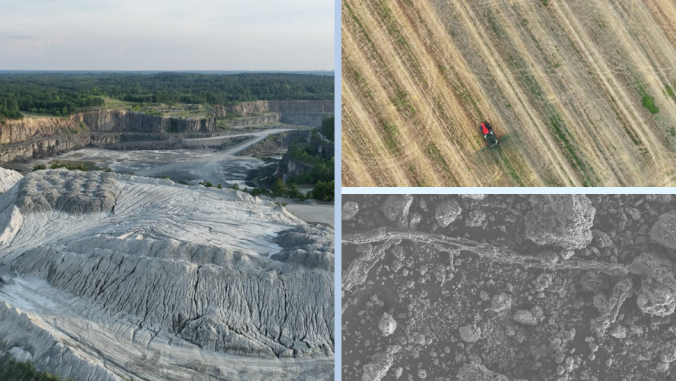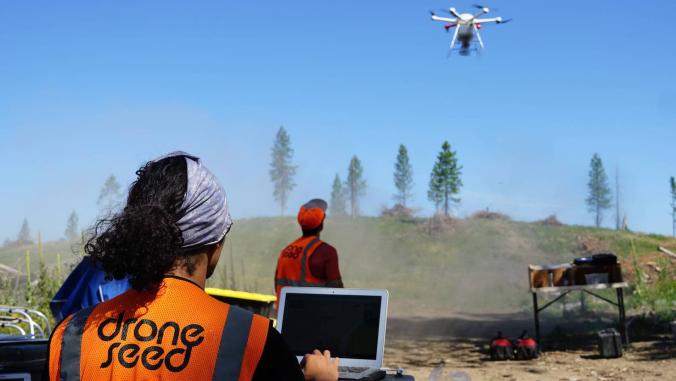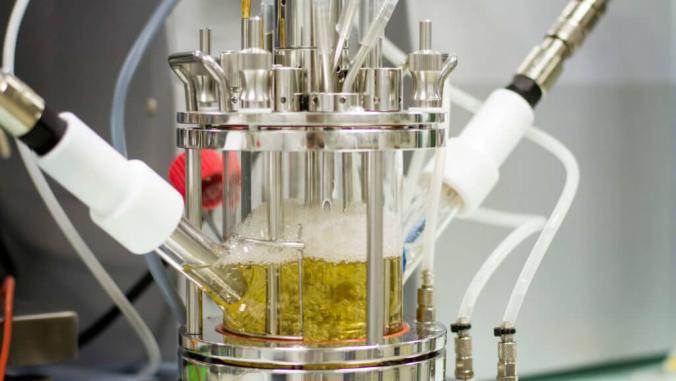The sensible, sexy and strange world of carbontech
The trillion-dollar market is growing startups, products and technologies, though capital deployment remains an obstacle.

Imagine walking into a supermarket, where you’re offered a free sample of a new protein shake with a secret ingredient. After a few sips (the shake’s delicious, by the way), you learn the secret isn’t some new super-kale or the latest magical supplement — what you’re drinking is carbon dioxide that was once belched out of a steel mill smokestack.
That day might not be as far off as you’d think.
The idea of pulling CO2 out of the air and turning it into a product to be sold for profit has been attracting a lot of attention lately, and even a few dollars. And the number of startups working in carbon capture and use (CCU), also known as carbontech, has ballooned in recent years. The Circular Carbon Network, a new nonprofit initiative launched by the XPRIZE Foundation and Pure Energy Partners to catalyze more investment and commercial activity in CCU, has already tracked more than 250 companies in the space.
"There’s a huge range of products we could make out of CO2," Marcius Extavour, executive director of the NRG COSIA Carbon XPRIZE, told GreenBiz. "So then the questions become: Which ones are the easiest to make? Which ones are cost-effective? And which ones would actually have a lower carbon footprint if you made them out of CO2?"
Some technologies that startups are pioneering are further along in market development than others, with a handful already at the commercial stage (most notably those that enrich concrete). Some have more carbon mitigation potential than others, because they conceivably could use more CO2 and/or lock it away for longer, while some have a larger total market potential. The volume of CO2 industrial products could use, for example, is significantly greater than that of commercial products.There’s a huge range of products we could make out of CO2. So then the questions become: Which ones are the easiest to make? Which ones are cost-effective?
In all, McKinsey & Co. estimates that by 2030, the CO2-based marketplace — including building materials, plastics, fuels, food and textiles — could be worth between $800 billion and $1 trillion.
There is a growing sense of urgency around scaling the market, too, and for good reason. We’re not currently on track to limit global heating, which has potentially disastrous consequences, and models indicate that doing so will require more than simply reducing current emissions. It will require "negative emissions."
The Global Carbon Initiative projects that, with the proper incentives, by 2030 the overall CO2-based product industry could capture and put to use CO2 equivalent to about 15 percent of current global emissions.
All of this is motivating investment in the space, although access to capital remains a primary challenge. Corporations, such as LafargeHolcim, the massive Swiss cement and concrete company, are partnering with CCU startups and providing funding, as are investors such as Bill Gates. And government incentives, such as the United States' "45Q" tax credit that passed last year, could help spur further investment.
With a little imagination, the range of products seems limitless. That’s because captured CO2, in theory, could be used to produce anything currently made with ingredients derived from fossil fuels. And practically everything that touches our daily lives that isn’t from plants, animals or minerals contains fossil fuels.
This includes any product made with plastic, such as toys, computers, cars and toothbrushes; asphalt, used to make roads and the synthetic rubber in tires; fertilizers, pesticides, herbicides, detergents, paints, etc.; synthetic clothing materials, from spandex workout pants to nylon jackets; not to mention tennis rackets, toilet seats, guitar strings, ice chests, disposable diapers, vinyl records, lipstick, motorcycle helmets and, of course, Vaseline.With the proper incentives, by 2030 the overall CO2-based product industry could capture and put to use CO2 equivalent to about 15 percent of current global emissions.
Replacing fossil fuels with waste CO2 doesn’t make sense in all cases. Sometimes there are better alternatives, such as eliminating a product altogether or replacing petroleum-based ingredients with plant-based ones, as many makers of shampoos, lotions and cosmetics already do.
Of the products that do or could make sense, the following four categories — building materials, liquid fuels, advanced materials and food — do not represent the largest chunk of the current potential CO2 marketplace. In terms of size, the current markets for industrial chemicals and durable plastics would be far greater than, say, advanced materials. However, each category has the unique potential that makes it compelling.
Making concrete strong, if not sexy
When people explain CO2 in concrete, at some point they’ll admit that nobody wants to talk about concrete. It’s not accessible like the solar panels on roofs or sexy like Teslas. Yet, as Extavour put it, "Concrete might sound boring, but it’s one of the largest materials markets on earth."
Indeed, when it comes volume, carbon mitigation potential and technological and market maturity, concrete is king, hands down. It represents the best prospect for widespread use of CO2 in the near-term because building construction and infrastructure around the world uses enormous amounts of it.
It’s such a large industry that the production of cement, the main ingredient in concrete, is responsible for roughly 8 percent of global greenhouse gas emissions. This also means the industry has its own potential CO2 source, so it can close the carbon loop. And when you inject CO2 into concrete, it stays there forever, making this one of the few uses of CO2 that is actually carbon negative.
"The whole reason to trap the CO2 in the concrete is to keep it from going into the atmosphere, but it also gives benefit to the concrete as well by making it stronger and more durable. It’s not just a straight up cost," Brett Henkel, vice president of strategic accounts and government affairs for Inventys Thermal Technologies, told GreenBiz.
Inventys, a Vancouver-based startup, is working on a CCU pilot project in British Columbia, with LafargeHolcim and the French energy company Total. The project, expected to be operational by the end of 2020, will be the world’s first to close a carbon loop by capturing and reusing CO2 from a cement plant.The industry has its own potential CO2 source, so it can close the carbon loop.
Other building materials, such as steel and wallboard, have some of the same characteristics as concrete — large global markets, significant carbon emissions and the potential to lock up CO2 for good. But the commercialization of CCU technology is further along in concrete, with companies such as Canada’s CarbonCure and New Jersey-based Solidia Technologies, also a LafargeHolcim partner, already serving the commercial market.
CarbonCure’s technology is in more than 150 concrete plants in Canada, the United States and Asia. The Nova Scotia-based company uses liquefied CO2 captured from various industrial sites and injects it into a concrete mixer, where the CO2 chemically reacts with water and calcium to form solid calcium carbonates. Because the CO2 makes the concrete stronger, it’s possible to use less cement, which reduces the carbon footprint further and brings costs in line with conventional cement, the company says. Right now, its carbon reduction is relatively small, 5-10 percent, but CarbonCure ultimately aims to develop carbon-neutral concrete.
Taking the guilt out of flying
Unlike building materials, CO2-based fuels are not carbon negative, because the CO2 is released again when the fuel is used. However, CO2-based fuels can help move shipping and aviation to carbon neutrality (removing the auto industry from the equation, as it’s already begun to transition to electric vehicles).
Companies such as Zurich-based Climeworks, Rotterdam-based SkyNRG, Carbon Engineering in Canada and Global Thermostat and LanzaTech in the United States, all of which have developed CCU technology for fuels, offer another alternative for reducing aviation CO2 emissions.
Carbon Engineering, which makes a liquid fuel by combining captured waste CO2 with hydrogen from water, seems to have taken an important step for the CCU space by developing a potentially cost-competitive way to make carbon-neutral gasoline, diesel or jet fuel.
Founded by David Keith, a Harvard professor of applied physics, the startup has been running a pilot project in British Columbia since 2015. In 2018, the design and engineering costs of the project were published in the journal Joule. The company managed to keep costs below $100 for each ton of CO2 removed from the atmosphere by using existing industrial processes to scale up. Until now, the costs of CO2 removal, or what’s known as "direct air capture," were believed to be at least $600 per ton.
The next step is to have a number of scaled-up plants producing hundreds of thousands of barrels of carbon-free fuel, to drive down costs further, much as solar and wind energy costs have plummeted over the past decades as scale has risen.
Jennifer Holmgren, founder of LanzaTech, said her company’s fuel also can be cost-competitive with conventional jet fuel when produced at commercial scale.The next step is to have a number of scaled-up plants producing hundreds of thousands of barrels of carbon-free fuel, to drive down costs further.
"However, we see a need for incentives to bridge the price gap initially," she told GreenBiz. "In five to 10 years, the incentives could tailor off as the fuel becomes competitive alone."
In 2018, a commercial Virgin Atlantic flight from Orlando to London Gatwick ran on fuel produced by LanzaTech, which uses not only recycled CO2 waste but also recycled greenhouse gas emissions from such sources as municipal solid waste, organic industrial waste and agricultural waste, along with reformed biogas. Lanza says it could produce as much as 125 million gallons of jet fuel per year in the United Kingdom to fuel 100 percent of Virgin Atlantic flights departing Britain, recycling nearly 1 million tons of CO2.
Both Carbon Engineering and Climeworks have developed a direct air capture system, which pulls CO2 from ambient air, rather than a smokestack. Calgary-based Carbon Engineering in June announced a $19 million investment from the Canadian government, which came on the heels of $70 million from private investors such as Gates and major oil and gas companies such as BHP, Chevron and Occidental Petroleum. Late last year, Climeworks said it had secured more than $30 million from existing and new private investors and Zurich Cantonal Bank, bringing its total funding above $50 million.
Climeworks and its partner SkyNRG have launched a pilot project in partnership with Rotterdam The Hague Airport to test the commercial viability of their CO2-based fuel. The pilot project will use waste CO2 captured from airline emissions at the airport with the aim to produce 1,000 liters of jet fuel a day, starting in 2021.
One caveat about the market for CO2-based fuels: they have competition from biofuels. Aircraft are already flying on renewable fuels made from plant biomass, such as sugar cane, grasses or palm oil, and even animal waste products.
Stronger, lighter and, well, cool
Carbon materials — graphene, carbon nanotubes, carbon fibers — made from CO2 are still in the early stages of development, and manufacturing them is expensive because it relies on electrochemical processes for conversion. However, the eventual market potential for these materials is huge — graphene is an efficient electrical conductor and one of the strongest materials known; carbon nanotubes are used in batteries, electronics, sporting goods and more; carbon fiber (made from carbon nanotubes) can be used in aerospace, energy, concrete, automobiles and sporting goods.
Engineered on a tiny scale and measured in billionths of a meter or nanometers, sometimes just a single atom thick, these materials are extremely valuable in part because they’re extremely strong and light. They can increase fuel efficiency by making cars and airplanes lighter, improve wind turbine performance, and boost the capacity of lithium-ion batteries. According to marketers, carbon fiber also makes high-performance sporting gear, such as bicycles and tennis rackets, "cool" and "sexy."
And while the amount of CO2 used in these products is small, they are durable, meaning CO2 could remain locked away in them for a long time.
Canada’s C2CNT, a finalist in the Carbon XPrize, has figured out a way to produce carbon nanotubes 100 times more cheaply than usual. Its technology uses low-cost nickel and steel electrodes and low voltage current to create carbon nanotubes from flue gas that conduct electricity better than copper. Valued at over $100,000 per ton, the nanotubes can be used by steel, aluminum, textiles, ceramics and cement producers, and in electronics, packaging, manufacturing and construction.
No dessert until you eat your CO2
And last but not least, back to that protein shake. A Finland-based company called Solar Foods has developed a process to use renewable electricity and CO2 to produce an ingredient that looks like wheat flour and contains 50 percent protein. The company, which plans to begin commercial production in 2021, aims to make food while avoiding the massive environmental footprint of agriculture.
Food made through fermentation, such as beer or lab-grown meat, relies on feeding plant sugars to microbes. The new process replaces those sugars with carbon. The process uses solar power to split water through electrolysis in a bioreactor, creating hydrogen that can give microbes energy as they’re fed carbon. The microbes produce a food that’s composed of roughly 20-25 percent carbs, 5-10 percent fat and 50 percent protein.
Because it’s totally disconnected from agriculture, the new protein powder, Solein, claims to be 100 times more climate-friendly than any animal or even plant-based alternative. It can yield 10 times more usable protein per acre than soy production, the company says.Food made through fermentation, such as beer or lab-grown meat, relies on feeding plant sugars to microbes. The new process replaces those sugars with carbon.
When it starts showing up in grocery stores — within the next two years, if all goes according to plan — it won’t be in its powder form but as an ingredient in products such as protein shakes, perhaps, or plant-based yogurt. That’s in part because it’s likely most palatable for consumers, but bags of CO2-based flour might not gain as much acceptance. For plant-based meat companies such as Impossible Foods, which focus on the environment, it could be a way to shrink their environmental footprints even further.
How consumers respond to food made from waste CO2 is a big and fascinating question. "It’s not just a technology story, it’s not just a business story, it’s a social story, too. Because consumer products are about what people like and don’t like, and that matters a lot," Extavour said.
Extavour also believes that making consumer products from CO2 matters, even if the volume comes nowhere near that of industrial products, because of the opportunity to raise awareness and connect people to the effort to decarbonize.
"It’s potentially a way for individual consumers to take climate action or engage brands and retailers in sustainability," he said.





